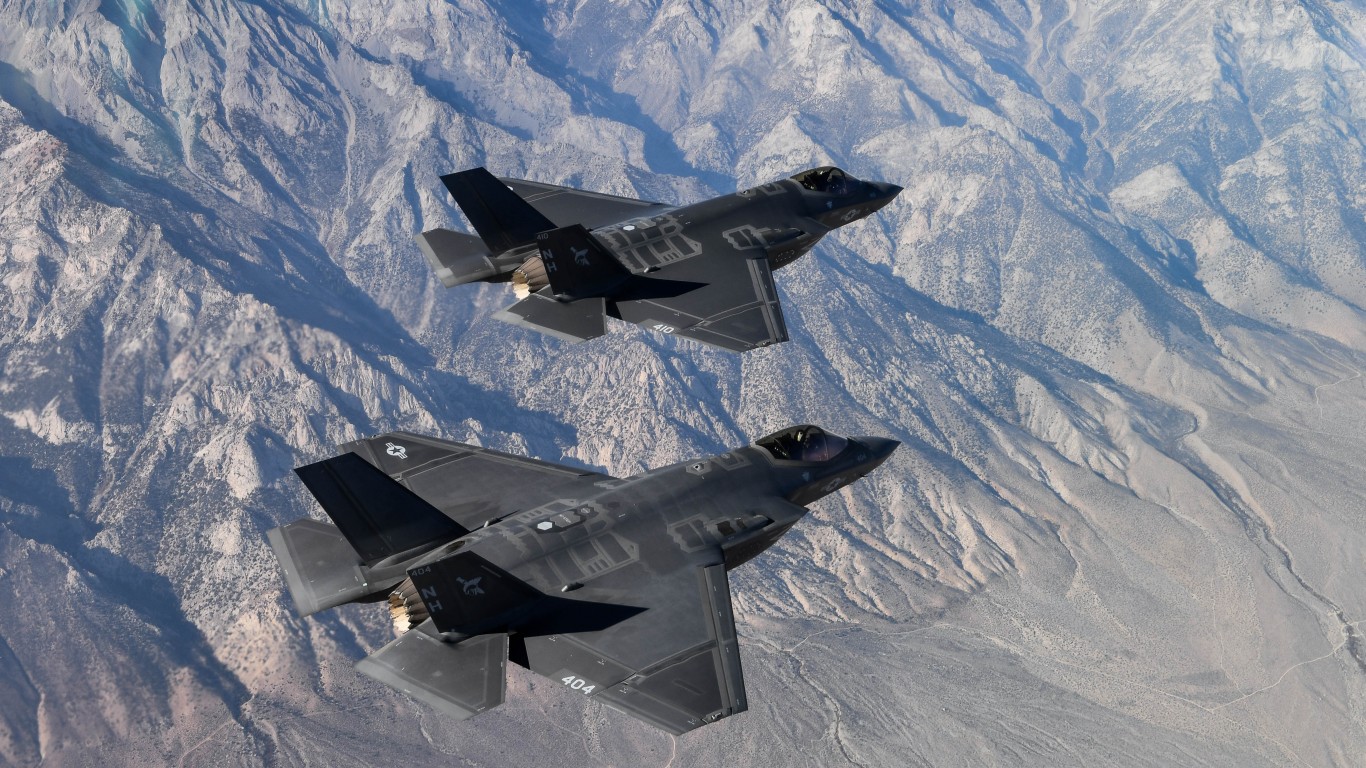
Saturday’s surprise Hamas attack on Israel and Israel’s armed response sent defense stocks higher Monday morning. Defense stocks were rising following announced U.S. support for Israel.
[in-text-ad]
U.S. Defense Secretary Lloyd Austin III said Sunday that an aircraft carrier and five guided-missile ships have been ordered to the eastern Mediterranean. More support has also been promised. That support includes more U.S. fighter and attack aircraft. Exactly what else the United States will supply has not been disclosed. (Every modern fighter jet ranked from slowest to fastest.)
U.S. Arms to Israel
Israel was the first foreign buyer for Lockheed Martin Corp.’s (NYSE: LMT) F-35 joint strike fighter, the most advanced aircraft in the U.S. arsenal. Israel agreed to purchase 50 of the jets and has taken delivery of 36 as of last November. In early September, Israel increased the order by 25 additional planes. It will pay for those planes with $3 billion in U.S. military aid to Israel.
According to the Stockholm International Peace Research Institute (SIPRI), Israel has acquired 150 advanced medium-range air-to-air missile (AMRAAM) systems built by RTX Corp. (NYSE: RTX). SIPRI data covers sales to Israel between 2000 and 2022.
Lockheed Martin sold 28 air-intercept missile (AIM) systems between 2015 and 2016. Lockheed has also sold 680 air-to-ground (AGM) anti-tank Hellfire missile systems to Israel. In 2021, Israel agreed to purchase 12 Sikorsky Ch-53K heavy-lift helicopters from Lockheed Martin, with delivery beginning in 2025.
The Pentagon has also transferred 72 AH-1F Cobra combat helicopters to Israel as part of two aid packages. Textron Inc.’s (NYSE: TXT) Bell Helicopter subsidiary manufactured the helicopters.
Israel has purchased 21 Apache combat helicopters from the Boeing Co. (NYSE: BA), and the country has ordered four Boeing KC-46A tanker transport aircraft, planned for delivery beginning in 2025.
Raytheon has sold 1,200 Paveway precision-guided bombs to Israel, with the last sale coming in 2019.
U.S. Military Aid to Israel
In March of this year, the Congressional Research Service (CRS) issued a report on U.S. foreign aid to Israel. Since 1946, U.S. aid to Israel totals $158.7 billion. For the 77-year period, military aid and missile defense account for $124.3 billion (78%) of the total. The remainder ($34.35 billion) is economic aid.
U.S. military aid to Israel includes a policy of maintaining a “qualitative military edge” for Israel over the country’s neighboring state. That means that the United States has given Israel first regional access to U.S. defense technology. If a neighboring state and Israel operate the same U.S. platform, the Israelis get the most advanced version or the ability to customize the U.S. system.
U.S.-Israeli Security Agreement
Since 1999, the United States and Israel have agreed to a periodic 10-year understanding on military aid for Israel. The two countries signed the latest agreement in 2016, covering the period between 2019 and 2028. The United States agreed to supply $38 billion in military aid to Israel, including $33 billion in foreign military financing and $5 billion in appropriations for missile defense programs.
[in-text-ad]
It is not a one-way street, however. In 2019, according to the CRS report, the United States purchased $1.5 billion worth of Israeli military gear. The gear includes tank protection systems, enhanced night-vision goggles and other equipment.
Impact of Russia’s Invasion of Ukraine on U.S. Aid to Israel
Since Russia’s 2022 invasion, Ukraine has been trying to persuade Israel to supply its Iron Dome system to aid the Ukrainian defense. Iron Dome is a short-range anti-rocket, anti-mortar, and anti-artillery system with an intercept range of 2.5 to 43.0 miles. The Israelis have resisted sending military aid to Ukraine but have promised up to $200 million in loan guarantees for health care and civilian infrastructure. Iron Dome is a joint product of Israel and the United States.
After Russia approached Iran for help with acquiring drones, Israel is transferring missile and drone early-warning systems to Ukraine.
U.S. aid to Ukraine is also in jeopardy due to the lack of a federal budget for fiscal year 2024. The Pentagon overestimated the value of arms shipped to Ukraine in fiscal 2023 by $6.2 billion. Some $5.4 billion could still be used to aid Ukraine. According to a Reuters story from Friday, the administration and the Pentagon are exploring other workarounds to continue supplying aid to Ukraine.
Defense Stocks Moving Higher
Northrop Grumman stock traded up about 11% in the noon hour on Monday, at $469.16, in a 52-week range of $414.56 to $556.27.
Lockheed Martin stock traded up nearly 6.8%, at $431.80, in a 52-week range of $388.10 to $508.10.
RTX stock traded up about 4.4%, at $72.85, in a 52-week range of 68.56 to $104.91.
Textron stock traded up about 2.2%, at $78.49, in a 52-week range of $58.80 to 80.60.
Boeing stock traded down 0.4%, at $186.68, in a 52-week range of $124.17 to $243.10.
Get Ready To Retire (Sponsored)
Start by taking a quick retirement quiz from SmartAsset that will match you with up to 3 financial advisors that serve your area and beyond in 5 minutes, or less.
Each advisor has been vetted by SmartAsset and is held to a fiduciary standard to act in your best interests.
Here’s how it works:
1. Answer SmartAsset advisor match quiz
2. Review your pre-screened matches at your leisure. Check out the advisors’ profiles.
3. Speak with advisors at no cost to you. Have an introductory call on the phone or introduction in person and choose whom to work with in the future
Thank you for reading! Have some feedback for us?
Contact the 24/7 Wall St. editorial team.
 24/7 Wall St.
24/7 Wall St.